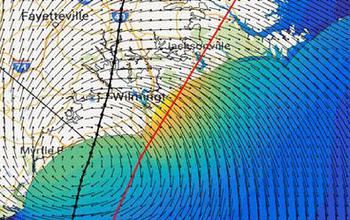Multimedia Gallery
A storm surge simulation computed using GENI resources is shown.
A storm surge simulation computed with the ADCIRC (a system of computer programs for solving time dependent, free surface circulation and transport problems in two and three dimensions) storm surge, tide, and wind-wave model on ExoGENI cyberinfrastructure. ExoGeni is a new GENI testbed that links GENI to two advances in virtual infrastructure services outside of GENI: open cloud computing (OpenStack) and dynamic circuit fabrics. The simulation is forced by surface winds and atmospheric pressure from the Weather Research and Forecasting (WRF) model, from a set of ensemble members representing possible evolutions of Hurricane Floyd (1999), which caused substantial storm surge, inundation and rain-related flooding in coastal North Carolina. The WRF winds are shown with the vector field, the simulated water level with the color surface in feet relative to mean sea level, and the ensemble member storm track with the black line. The true Floyd best track is shown in red. The water level reaches about 12 ft along the North Carolina coast, east of Wilmington.
Credit: Brian Blanton, Renaissance Computing Institute, UNC-Chapel Hill
Images credited to the National Science Foundation, a federal agency, are in the public domain. The images were created by employees of the United States Government as part of their official duties or prepared by contractors as "works for hire" for NSF. You may freely use NSF-credited images and, at your discretion, credit NSF with a "Courtesy: National Science Foundation" notation.
Additional information about general usage can be found in Conditions.
Also Available:
Download the high-resolution JPG version of the image. (98.0 KB)
Use your mouse to right-click (Mac users may need to Ctrl-click) the link above and choose the option that will save the file or target to your computer.
Related story: From programmable backbones to advanced 'apps': An end-to-end vision of the future Internet



